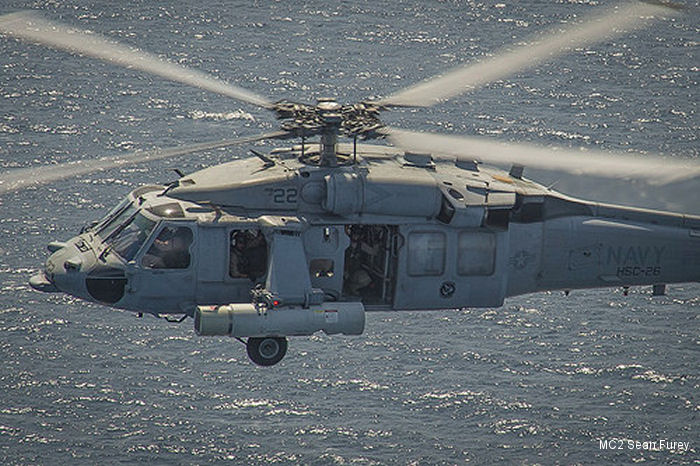
US Navy, August 06, 2014 - MANAMA, Bahrain - The U.S. Navy has forward deployed the Airborne Laser Mine Detection System (ALMDS) to the 5th Fleet area of responsibility (AOR).
ALMDS is a sensor system designed to detect, classify and localize floating and near-surface moored mines. Operated from the MH-60S helicopter, ALMDS provides rapid wide-area reconnaissance and assessment of mine threats in littoral zones, confined straits, and choke points.
Sailors from Helicopter Sea Combat Squadron (HSC) 26, Detachment 2, Laser Hawks, began the operational testing and demonstration of ALMDS in 5th Fleet on the system’s maiden deployment Aug. 4.
“The U.S. Fifth Fleet is focused on reducing the threat posed by sea-based mines in the region should that be necessary and the presence of ALMDS here in the theater adds to our capacity to do just that,” said Vice Adm. John W. Miller, commander, U.S. Naval Forces Central Command, U.S. 5th Fleet, Combined Maritime Forces. “The international community has a critical shared interest in the free flow of commerce in this region. ALMDS, along with the many other counter-mine systems we operate in the Fifth Fleet allows the Navy to keep the sea lanes open.”
“It’s a laser-driven system that works like radar,” said Lt. Cmdr. Theodore Lemerande, officer in charge of Laser Hawks. “It beams a laser down into the water and picks up reflections from anything it bounces off of. The system then registers the returned information and uses that data to produce a video image in order for technicians on the ground to determine what the object is.”
The Navy’s largest helicopter, the MH-53E Sea Dragon, has been a critical component of the Navy’s ability to perform the airborne countermine mission in the Fifth Fleet and elsewhere for many years. ALMDS expands the countermine mission to smaller MH-60S helicopters.
“MH-60Ss have traditionally been a platform for anti-surface warfare, combat support, humanitarian disaster relief, combat search and rescue, aero-medical evacuation, and special warfare,” said Lemerande. “ALMDS allows us to take airborne mine countermeasures technology to these smaller helicopters that can fly from smaller ships allowing us to take mine countermeasures into places that may not have been accessible before.”
U.S. Naval Forces Central Command’s (NAVCENT) scope of maritime operations covers approximately 2.5 million square miles of area including the Arabian Gulf, Gulf of Oman, North Arabian Sea, Gulf of Aden, and the Red Sea. NAVCENT's mission is to conduct maritime security operations, theater security cooperation efforts, and strengthen partner nations' maritime capabilities in order to promote security and stability in the U.S. 5th Fleet area of responsibility.
ALMDS is a sensor system designed to detect, classify and localize floating and near-surface moored mines. Operated from the MH-60S helicopter, ALMDS provides rapid wide-area reconnaissance and assessment of mine threats in littoral zones, confined straits, and choke points.
Sailors from Helicopter Sea Combat Squadron (HSC) 26, Detachment 2, Laser Hawks, began the operational testing and demonstration of ALMDS in 5th Fleet on the system’s maiden deployment Aug. 4.
“The U.S. Fifth Fleet is focused on reducing the threat posed by sea-based mines in the region should that be necessary and the presence of ALMDS here in the theater adds to our capacity to do just that,” said Vice Adm. John W. Miller, commander, U.S. Naval Forces Central Command, U.S. 5th Fleet, Combined Maritime Forces. “The international community has a critical shared interest in the free flow of commerce in this region. ALMDS, along with the many other counter-mine systems we operate in the Fifth Fleet allows the Navy to keep the sea lanes open.”
“It’s a laser-driven system that works like radar,” said Lt. Cmdr. Theodore Lemerande, officer in charge of Laser Hawks. “It beams a laser down into the water and picks up reflections from anything it bounces off of. The system then registers the returned information and uses that data to produce a video image in order for technicians on the ground to determine what the object is.”
The Navy’s largest helicopter, the MH-53E Sea Dragon, has been a critical component of the Navy’s ability to perform the airborne countermine mission in the Fifth Fleet and elsewhere for many years. ALMDS expands the countermine mission to smaller MH-60S helicopters.
“MH-60Ss have traditionally been a platform for anti-surface warfare, combat support, humanitarian disaster relief, combat search and rescue, aero-medical evacuation, and special warfare,” said Lemerande. “ALMDS allows us to take airborne mine countermeasures technology to these smaller helicopters that can fly from smaller ships allowing us to take mine countermeasures into places that may not have been accessible before.”
U.S. Naval Forces Central Command’s (NAVCENT) scope of maritime operations covers approximately 2.5 million square miles of area including the Arabian Gulf, Gulf of Oman, North Arabian Sea, Gulf of Aden, and the Red Sea. NAVCENT's mission is to conduct maritime security operations, theater security cooperation efforts, and strengthen partner nations' maritime capabilities in order to promote security and stability in the U.S. 5th Fleet area of responsibility.
See also |
Sikorsky MH-60S Seahawk
HSC-26
Sonar
More MH-60S Airborne Laser Mine Detection Systems
Laser Mine Detection System in BALTOPS 2019




